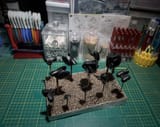Search Results
7/23/2025, 4:11:48 PM
>>11499168
Like any thing or process, priming can be helpful or unhelpful depending on the circumstances, there is no one size fits all rule.
You might want to prime when
>you have resin and/or metal
>the surface has defects that need one or more rounds of fixing (including defects you created yourself while seam welding etc)
>you want to simulate shadows in recesses and hard to reach areas
>you are using non-lacquer paint
You might want to skip priming when
>the surface has intricate detail that primer can fill in
>the surface is already perfect and you plan to paint shiny metallics like chrome
>the surface is the right color that you want to use as is to match the part you can't paint (e.g. skin tone to match the face plate with pre-applied eyes)
Like any thing or process, priming can be helpful or unhelpful depending on the circumstances, there is no one size fits all rule.
You might want to prime when
>you have resin and/or metal
>the surface has defects that need one or more rounds of fixing (including defects you created yourself while seam welding etc)
>you want to simulate shadows in recesses and hard to reach areas
>you are using non-lacquer paint
You might want to skip priming when
>the surface has intricate detail that primer can fill in
>the surface is already perfect and you plan to paint shiny metallics like chrome
>the surface is the right color that you want to use as is to match the part you can't paint (e.g. skin tone to match the face plate with pre-applied eyes)
Page 1
